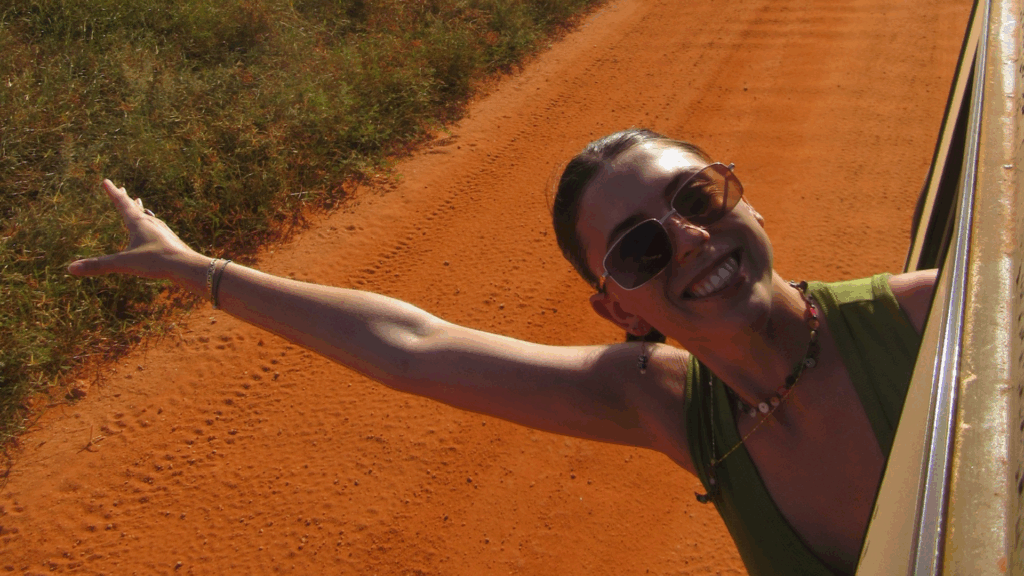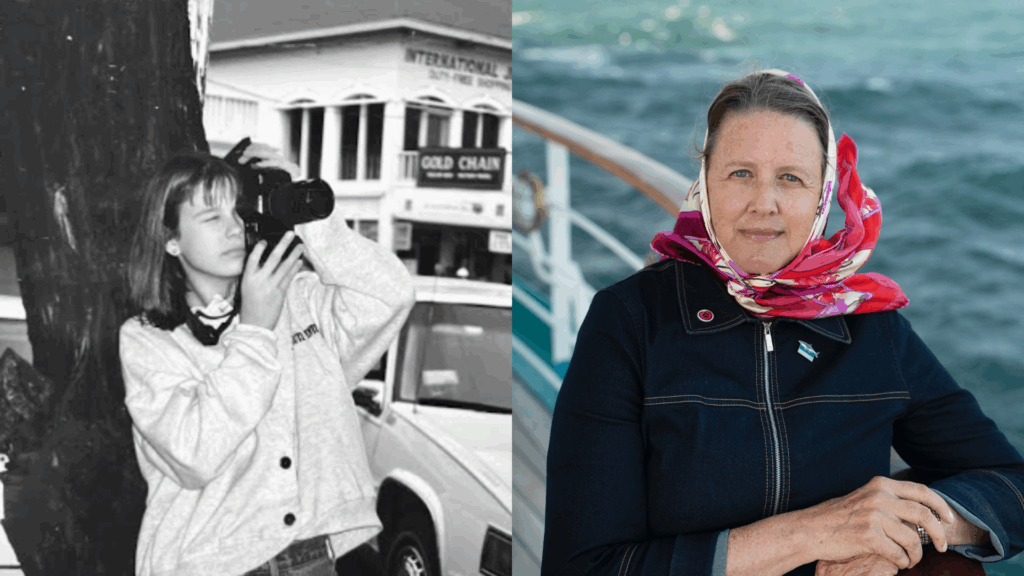
There are still a few places on earth that hold mystery and adventure in their veins. They whisper danger and untamed wildness and breathe fantastical vistas and hidden cities into your ear. The great Brazilian Amazon is one of those places. Mythologized as much for its unique ecosystem as for the folly of many a would-be adventurer, the Amazon calls to city dwellers and country folk alike, beckoning with its wide waters while hiding ancient rainforests in its depths.
Brazil was one of the most anticipated ports on the Fall 2015 Voyage. Docking in Bahia’s capital of Salvador, the field office organized three excursions to the Amazon. One of those groups, the Amazon Lodge Expedition, left with 22 participants from the ship at 2:30am, blinking back sleep as we were handed a boxed breakfast and boarded a bus to the airport and made our way to Manaus, the industrial city in the middle of the Amazon jungle.
We landed in Manaus and changed transportation to another touring bus, which drove us through the city to the industrial open-air docks, with a bustling fish market for locals and a souvenir market for tourists touted its wares. At the end of the docks, the river we’d come for, the mighty Amazon lazily flowed past. Not the roaring rush we expected from the river in our dreams, but expansive and impressive nonetheless. We eagerly boarded a covered riverboat that took us directly into the center of the river. Called the meeting of the waters, the dark Rio Negro collides with the milky Upper Amazon, and the two dance for six long miles before creating a uniform color as they flow downstream. Pink dolphins, the ugly freshwater cousins of their better known sleek gray dolphins, jumped and swam between the dark and light waters, as if they were showing off just for us.

After crossing the river, we boarded a small bus (that’s three buses so far, for those of you counting at home) and trucked down a paved road until it became bumpy clay and dirt for an hour before coming to the Mamori tributary, the section of the Amazon we were to call home for three days. December is low season, so the water is some 15 to 20 meters (50 to 65 feet) below what it is in high season, which would reach the top of the “hillside.” At the bottom, a dock store, one of many along the banks of the Amazon, sold dry goods, candies, a cooler of water and sodas, and an Amazonian and worldwide favorite, ice cream. Barrels of gas doubled as seats in the corner, and we sat on them, sucking on popsicles to cool off in the sweltering heat while waiting for our next form of transportation.
Two canoe boats with small motors took us to our final destination, Amazon Turtle Lodge. Twisting and turning to avoid trees, tall grasses, and other hazards in the waters, our guide, Herman, made a stop along the banks, running the boat directly into the hillside. We leapt out and hiked up to a dinosaur. Known to local Amazonians as the “mother of all trees,” Kapok trees reach heights of 200 feet and their trunks alone can grow to encompass 10 feet in diameter. This Kapok or Ceiba tree is over 400 years old, and sprawling roots reached heights of nine feet.

Awed, we continued down the river, taking in the surrounding jungle, broken only by the occasional farm or human altered pasture until we arrived at the lodge. We were met at the dock with fresh fruit, pineapple so sweet it tasted like candy, freshly squeezed guava and acai juices, and incongruously, tiny slices of pizza. We gratefully devoured the offered food and drink before hiking up the 65 steps to reach the concrete bungalows of Amazon Turtle Lodge.
Nearly 12-hours after leaving the MV World Odyssey, we lounged on hammocks under palm roofed huts and played soccer in the field between lodges. We all met for dinner in the restaurant, an open-air circular building that comprises the common area of Turtle Lodge. Exhausted, we retired to our lodges to fall asleep surrounded by the sounds of the jungle.
Before sunrise the next morning at 5am, we convened at the dock for a bird watching river tour. We interrupted the peaceful morning quiet with our roaring motor, but the several species of egrets, hawks, and macaws seemed to care little for our rowdy intrusion on their morning. Pausing in a grove of river grass that rippled with the waves like rolling fields, we watched the sun ascend into the sky, lightening the gray world to vibrant greens and browns.
Back at the lodge, we put on our adventure gear to prepare for a four-hour trek in the jungle. Long sleeves, closed toe shoes, hats, plenty of sunscreen and bug spray later, and we boarded our boats from the morning, this time running aground on an unassuming hillside leading into the jungle. Herman hacked his way through the jungle as we timidly followed, staring up into the canopy as if in a daze, light filtering down in tiny sunbeams of light, penetrating a green cloud covering the sun. We stopped at a tree with a mini-fridge sized bulge of what looked like discolored bark. Herman explained that these were leaf cutter ants, and their nest was an excellent natural mosquito repellent. He touched the outside of the nest until the ants swarmed over his hand, then casually but firmly brushed the ants down and off his hand. He then asked if we would like to try, and one by one, we placed our hands on the nest until we couldn’t stand the crawling on our skin (roughly two seconds) and not as deftly, attempted to remove the ants from our skin without them climbing up into our clothes, some more successfully than others.
Continuing further into the jungle, we passed ancient palms and walking trees that actually grow new roots out of their trunk to find light filtering down the canopy. Coming to a small hill Herman motioned for us to stop around a grapefruit-sized hole in the ground. “If you see a clean hole with nothing obstructing it, something’s probably living there,” he warned. He gently patted a small stick at the entrance of the hole to draw out the creature living inside. Hairy legs tentatively crept out to reveal a Goliath birdeater tarantula. Our guide quickly closed off the entrance back to its burrow with his machete as we stared wide-eyed, at the world’s largest spider. Its leg span was at least nine inches. As soon as Herman moved the machete, our giant friend darted back into his burrow as quickly as his eight legs would take him.
Somehow, Herman spotted a tiny poison dart frog, that even in the guide’s (plastic covered) hands, seemed cloaked in camouflage. Less than half an inch long, the black and bright green frog had enough venom in his skin to paralyze a human on contact with a cut or open wound, hence the plastic barrier. If someone did happen to fall prey to the poison, Herman told us, another person would have to keep the paralyzed person’s heart and lungs moving for up to 20 minutes before the poison passed. He released the tiny frog onto a leaf, where it proceeded to leap at a group of terrified voyagers, who, hundreds of times the size of the creature, screamed and ran as far and fast away as possible. So the frog got his revenge for being unceremoniously handled in the end.
Harvesting fruit and nuts in the high canopy is no easy feat. Herman demonstrated a traditional climbing method by putting his feet in a loop created from palm leaves and shimmying the feet up the tree. Herman shot up the straight trunk of the tree to about 30 feet high in as many seconds. We all had a try, and a fail, at this seemingly easy method.
Back at the lodge, sweaty and victorious in our jungle trek, we collapsed into hammocks as a brief rainstorm swept through the area, leaving behind a cool breeze in the afternoon air.
The sun was beginning to fall behind the jungle canopy as we boarded two canoes on the river. Slowing as we passed floating houses and fishermen, and speeding up on the few straightaways the river provided. We stopped at a copse of river grass and were each given a crude bamboo fishing rod that line and a hook was hand tied to. Herman attached a cube of raw beef to each of our hooks and then demonstrated the subtleties of piranha fishing, which involved dropping the line into the water, waiting for the tiniest nudge on the line, and a swift yank to embed the hook. Fishing for piranhas was a little more like feeding the piranhas, as they were able to steal the meat seemingly without ever encountering the hook at all, and several a line was pulled up with neither fish nor meat attached. Quite a lot of beef and a half hour later, nearly everyone had pulled up (and released) at least one piranha. One eager Life Long Learner pulled his fish into the canoe, where it somehow leapt off the hook and into the bottom of the canoe amidst unclad feet. We quickly pulled up our feet onto the sides and waited for Herman to remove the jumping, saw-toothed fish and throw him back into the water. No humans ended up harmed in the process, though Herman did show us his scarred hands from piranhas, caimans, and snakes, the hazards of a lifetime guiding tourists in the Amazon.
The sun was hidden behind the hillsides as we motored back toward the lodge, but with a mission along the way. Herman shone his flashlight on the shores and into the jungle, and nearly everywhere, tiny lights shone back. He was looking specifically for red lights, the eyes of caimans, related to the American alligator. Herman slowed our boat to a whisper, and without a word, dove his arm into reedy grasses and pulled out a three-foot long spectacled caiman. He shone a flashlight into its eyes, temporarily blinding the caiman. Herman handed the caiman around the boat to willing participants, who firmly held the caiman behind the head and at the tail, before we returned the stunned creature to its river home. Our predator pursuit complete, we headed back to the lodge for a restful sleep.
On our too soon last day on the Amazon, we visited a family farm to learn about traditional growing and harvesting in such a challenging climate. The “plantation” consisted of a small house on stilts, free roaming chickens, cats and dogs, and small orchards growing guava, pineapples, bananas, and the most important product for the local people, manioc. Manioc, also known as Brazilian arrowroot, tapioca or cassava, is eaten with nearly every meal and is a staple food for many Brazilians. The root of the Cassava shrub, manioc tubers are toxic, and must be processed in a specific way to remove its cyanide. Traditionally in Brazil, the ground tubers are mixed with water and spread in a thin layer over a woven basket to dry in the sun, where the cyanide evaporates from the mix, making the flour safe to consume.

Reversing our boat to bus to boat to bus route to Manaus, we took a driving tour of the city, industrial city sprawl with a candy colored colonial center, with the crown jewel salmon pink opera house. Surrounded by a square with an epic fountain with four decorated ship bows facing the four corners of the Earth. Pale and dark bricks ripple the square, mimicking the dark and light waters of its lifeblood, the Amazon. We ate street food, breathing one final sunset so close and so far from the jungle and river we’d come to experience. The Amazon now forever mythologized in our memories.


